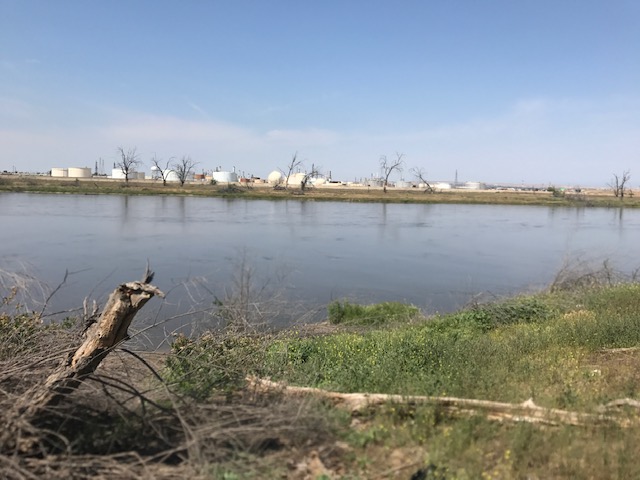The Semitropic Water Storage District board of directors held its Wednesday, September 14, 2022 at its Wasco headquarters and online with GoToMeetings – a step above MS Teams. I checked my files before the meeting began out of curiosity of how long I have been attending SWSD. Since 2017, five-years of semiregular attendance. In this time I’ve met some of the finest folks I’ve known. Will Boschman and Marsha Payne, former General Manager and Board Secretary respectively, have both made indelible imprints on me for their kindness, vast amount of knowledge and wisdom. I’m thankful I had the privilege of getting to know them and see the character of people tasked with making ag irrigation supplies available.
We hear stirrings of the desire for the state government to possess all the water rights and the State Board has adopted a resolution that the current water right system is based on systemic racism. California’s Department of Water Resources currently has an employee named Megan profiling water related special districts’ directors – sorting them by sex and racial type. She’s doing this by going to the district websites and looking up the bios and photos of directors to see if she can tell by looking if they are male or female and if they are white or some other race. She’s on the site and presumably there is a phone number listed. Why not call and confirm instead of guessing? Maybe because the goal of this racial and sexual profiling is to compare the make up of the board to the population it serves. As if you can measure someone’s character by their sex and skin color. Did you know there is a state agency profiling elected officials? Let me know what you think about that.
The Meeting
The meeting was called to order at 12:31pm by Chairman Dan Waterhouse who also led us in the flag salute. The in person guests were introduced and there was no public comment. General Manager Jason Gianquinto introduced a man familiar to our readers, Scott Hamilton who gave the board an update on the Water Blueprint of the San Joaquin Valley. Just like I only recently realized Semitropic is one word (I’ve been calling it Semi Tropic) I’ve been using the term San Joaquin Valley Water Blueprint as the official title of the organization. Semitropic is also a member of the South Valley Water Coalition which has similar goals to the Blueprint.
The Water Blueprint for the San Joaquin Valley
Hamilton said Semitropic has been supporting efforts to bring more water into the Valley. There are many entities working to do this but the efforts were fragmented and uncoordinated. The Blueprint is a broad based organization unifying the water voice of the Valley. It is not just ag based. The goal is to provide the vital water to everyone – habitat, disadvantaged communities, non-directly ag based businesses will benefit.
Hamilton said there is some momentum building and the goal is to bring in more surface water for recharge basically. As the amount of stress on groundwater increases, the amount of surface supply decreases. There is an estimate of a two million acre feet shortfall of surface water annually when all things are taken into account. The good news is there are substantial but sporadic amounts of water flowing out to sea under the Golden Gate from the Delta during wet years. This averages out to 10 million acre feet per year. Currently there isn’t enough infrastructure to take advantage of this wet year surplus.
Additional conveyance is needed to bring these supplies into the Valley. However, the first step is to get the water from the Delta or the canals are moot. Hamilton reminded the board up to 20 percent of the Valley’s farmland is in jeopardy of being permanently fallowed. There will still need to be fallowing even with the Blueprint in play. Disadvantaged communities will also either be helped by the Blueprint or harmed by increased fallowing. He gave an example of Arvin Edison WSD. Every time that district fills its recharge basin the City of Arvin’s groundwater supplies improves in quantity and quality.
The Blueprint proposes bringing fish screen technology into the 21st century with the Fish Friendly Diversion. Instead of louvered screens in the current of the river the idea is to build a facility about 200 acres big that has perforated pipes underneath the surface of the ground. The water will soak into the subsurface, be collected in the pipes and feed into collector canals that move the water to the pumping plants. No fish would be entrained in the pumps or one way diversion structures.
A pilot project is needed. This would give the concept validity and yield necessary data. Will the microscopic food chain be impacted? Will there be any biofouling in the pipes? The engineers believe this is scalable and the pilot project will be a proof. The cost for this pilot is $4 million.
The Blueprint asked Senator Shannon Grove for $7 million for the pilot project and to help cover the Blueprint. She tried but that didn’t make to through the Sacramento machine. State Water Project contractors are wrestling with the Delta tunnel. If State Project is going to step up it will have to come from the Kern County Water Agency.
Director Jon Reiter asked about the need to increase the output of pumping plants in the Delta? He also asked if the cross valley conveyance is increased would that cause a decrease in Article 21 water in Kern County? Hamilton said politically there is very little opportunity to expand the pumps and the water rights won’t be impacted so the priority of supplies will remain the same.
Hamilton said during the wet years like 2017 the ability to pump from the Delta could go into June and maybe even July. But even in normal years there is a great deal of surplus water that can be used. He said there is a very entrenched opposition to moving more water from the Delta. The governor needs to fully understand the Fish Friendly Diversion has great benefits to Southern California, the San Joaquin Valley and thousands and thousands of acres of wildlife habitat. That’s a good trade off.
Hamilton was asked what the fish and fauna agencies think about this. He said the agencies are often being pulled in many directions. They are going to want habitat and fish kill reductions and they are never going to be satisfied was what I hear between the lines. That’s why administration support is key. Rieter asked if Antonio Villaraigosa has a roll to play in this? Hamilton said there has been a Water Resiliency Portfolio and more recently the Water Strategy coming from the governor’s office. This plan would work well with this and again the administration needs to be on board.
Gianquinto said Hamilton has been working on this for a long time. Waterhouse asked what Kern County can do? Gianquinto said some funding support is needed to get the pilot project in place. Hamilton said political consultant and former state senator Dean Florez has been very helpful and this needs to be in the upcoming budget spending. Rieter said he participates in the Collaborative Action Plan, a sister organization to the Blueprint that brings in a diverse group of stakeholders to work – collaboratively. He said this pilot project needs to be make it so.
Action Items
Next the board moved and passed: to authorize the teleconference meeting, approve the agenda, the minutes, the treasurer’s report, the financial reports as presented by Controller Bobby Salinas and pay the bills. Gianquinto and Salinas gave some water accounting explanations that have impacts on bond ratings. Standard & Poore dropped Semitropic’s bond rating from A+ to A, but S&P downgraded every ag water related bonding agency west of the Mississippi River. In the over all scheme of things this didn’t really impact the district much one way or another.
The second to last action item was a request by a landowner who is converting farmland and building an industrial project on 200 or so acres that will reduce its water consumption to well below 100 a/f but with recycling that number will drop to 40 a/f annually. Gianquinto said this is part of the GSA review. He showed the board the Kern Groundwater GSA form as an example that could be duplicated with some slight changes for the Semitropic GSA. Kern County is updating its permitting requirements in light of the Executive order N-7-22. A decision wasn’t made today but this will be revisited next month.
State Senator Melissa Hurtado introduced SB 1084, a bill that will limit the purchase of land by foreign governments. Florez said this should appear on the Governor’s desk soon. Gianquinto said this bill limits the property rights of Semitropic landowners. Waterhouse said this bill goes too far and could lead to the restrictions of land transactions. Rieter said he agrees and called it overreaching. The board directed Gianquinto to send a letter to the governor in opposition.
SGMA
Gianquinto said there wasn’t much to update but for the ability to kickoff of the work with Land IQ for remote sensing in Kern County. A facilitation grant has come through. Work will also start with Todd Groundwater for a subbasin wide modeling project. He also said there hasn’t been any comments so far on the rewritten GSP.
Consultant Reports
Rick Amie with W.M. Lyles is on vacation but his report is in the board package. Larry Rodriguez of GEI Engineering gave a progress report saying the groundwater model has been calibrated. He said a grant for the Poso Creek Group totaling $2.9 million was submitted.
Florez gave his report saying the presentation by Hamilton was great. He and others spent some time at Semitropic going over a game plan on getting administration support for the Blueprint. He said he believes Villaraigosa can get Gavin Newsom at the very least neutral on the Blueprint solution. There is going to be a great deal of pushback to moving water out of the Delta but Florez said he sees a chance to get some money for the pilot program. Florez said this was a good move by Gianquinto to get the folks together to have the discussion. He also added he thought the bill by Hurtado was a camel’s nose under the tent even though the Farm Bureau is supporting this.
Florez said AB 2201 was held back through concerted effort in Sacramento by moderates and this most disastrous bill was killed for now. He also said attorney Steve Torigiani did a great job on this as well. Good for him. Florez said the court ruling that slapped the State Board’s hands for overreach in curtailing pre-1914 water rights was a very good development in showing the State Board there needs to be other approaches to drought besides curtailments.
Greg Allen gave the Red Trac report. He said he was flying yesterday and the pilot came on the PA saying he would be short, declaring they’d be in Oakland in hour and the weather was nice. Allen said he’d do the same. His follow up comment was the retrofit project is complete and yielding data. Energy costs are going up and it would be a good time to review the cost of lifting water.
Staff Reports
Gianquinto said the comment period for the Delta tunnel project is open and the Kern County Water Agency is working on this. KCWA is also one of the contractors working on the Voluntary Agreements with DWR. He hasn’t seen this language yet but has requested it be released before it goes to the State Board.
Gianquinto said it looks like the third La Nina year in row but our reservoir storage is way better than last year – it still isn’t great but better is better. He said to expect all lot of withdrawals from the banking side of things.
There has been nothing new on the Kings River appropriation status. He believes the State Board’s Hearing Office wants to clear the Kern River case before moving on. He said there are rumblings AB 2201 will be reintroduced next year. It’s more than rumblings, the author Assemblyman Steve Bennett stated in Cal Matters he will reintroduce the bill.
There was about $9,000 of goods and equipment stolen from a Semitropic facility and the Kern County Sheriff’s Office is investigating. With that the meeting went into closed session at 2:07pm and that was that.
DISCLAIMER OF RESPONSIBILITY; Waterwrights strives to provide its clients with the most complete, up-to-date, and accurate information available. Nevertheless, Waterwrights does not serve as a guarantor of the accuracy or completeness of the information provided, and specifically disclaims any and all responsibility for information that is not accurate, up-to-date, or complete. Waterwrights’ clients therefore rely on the accuracy, completeness and timeliness of information from Waterwrights entirely at their own risk. The opinions expressed in this report are those of the author and do not represent any advertisers or third parties.
ALL RIGHTS RESERVED. Copyright 2022 by Waterwrights/Don A. Wright.
SEMITROPIC WATER STORAGE DISTRICT
1101 Central Avenue, Wasco, CA 93280-0877 • 661-758-5113 • mail@semitropic.com
Board: Dan Waterhouse – President, Rick Wegis – Vice President, Tom Toretta – Treasurer, Todd Tracy – Secretary, Philip W. Portwood, Jeff Fabbri, Tim Thomson
Staff: Jason Gianquinto-General Manager, Bobby Salinas–District Controller, Isela Medina–District Engineer, Executive Secretary-Marsha Payne, Consultant-Will Boschman, Superintendent-John Lynch & Attorney
About: Semitropic Water Storage District is one of eight water storage districts in California and is the largest in Kern County. The District delivers water to nearly 300 customers for the irrigation of approximately 140,000 acres for agricultural uses. Semitropic also supplies energy to a variety of users and provides groundwater banking and storage services. Established in 1958, Semitropic Water Storage District covers an area of more than 220,000 acres. It began as an irrigation district for the purpose of securing State Water Project supplies to reduce groundwater overdraft. From www.semitropic.com

































